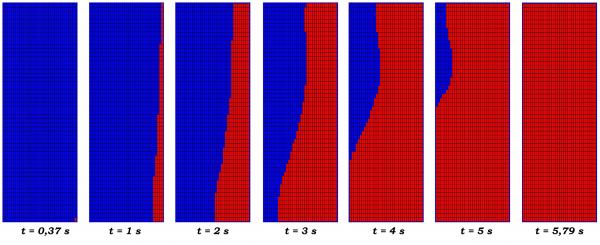
ISEULT-Neurospin project. Transverse normal zone propagation in the coil. CAST3M finite element computation.
Protection is a key issue for the study and the design of superconducting magnets. If the magnet transits irreversibly from a superconducting state to a normal state, its stored magnetic energy needs to be discharged while respecting two conflicting constraints: limiting the maximum temperature in the coil and keeping the voltage in relation to ground at a reasonable value. This requires a good grasp of the propagation kinetics of the normal zone in the coil, among other things.
Because analytical studies would be impossible to carry out in most cases, SACM uses several numerical codes suitable for multidisciplinary problems such as this, in which there is significant coupling between thermal, electromagnetic and sometimes fluid mechanics issues.
These are either codes written entirely by SACM (in Fortran, Matlab and Qtransit), or publicly or commercially available codes with accessible sources, which we have been modified and adapted to our needs (CAST3M). Finally, another possibility is that of a commercially available code with a dedicated module suitable for this study (Roxie).
The Qtransit code can be used to evaluate the protection of one or more superconducting magnets with study of the electrical circuit (with or without energy dump resistors), taking into account propagation of the resistive zone in three dimensions and temperature elevation in the magnet; passive or active quench-back devices (heaters) can also be added. It is suitable for the study of LTS magnets (NbTi or Nb3Sn); the detectors at CERN, CMS and ATLAS were studied with this code.
Thermal procedures in CAST3M allow the stability and propagation of the resistive zone to be studied in more details; these calculations can be made in 3D (study of superconductor cable Minimum Quench Energy (MQE)) or in 2D (quench propagation in the section of a magnet) depending on the number of elements in the model. The stability and protection of the FRESCA2 magnet were studied using these procedures, which might also be suitable for studying HTS magnets. A recently developed Fortran code allows for the study of HTS NI (No Insulation) or MI (Metal as Insulation) coils and of quench propagation taking into account current redistribution between turns via contact resistance.
These codes are constantly being improved/developed and can cover a broad spectrum of applications: “dry” or “wet” magnets with “traditional” insulation or no insulation. Within SACM there are around a dozen users of these codes, half of them experts/developers.
• superconducting magnet physics and technology › Instrumentation and development for R&D magnets
• Accelerators, Cryogenics and Magnetism Division (DACM)
• LEAS



